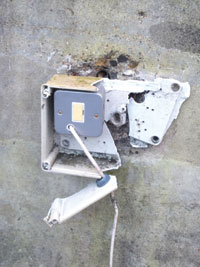
Posted to News on 27th Jul 2015, 00:00
They're not all little boxes and they're not all the same
Steve Gallon of Fibox explains that although many enclosures may look the same, many can be as different as chalk and cheese.

>Those readers of a similar age to myself will recall the Ed Stewart show on BBC radio every Saturday morning, playing all those horrible songs which were the soundtrack to our formative years. I never dreamed that one in particular would carry such relevance all these decades later. Who remembers "Little boxes on the hillside. Little boxes made of ticky tacky. And they all look just the same?"
>If the song was to be written today the next line might be "And then came Fibox," because now enclosures are most certainly not all the same, and different enclosures can mean success or failure in different applications. The photograph shows only too clearly what can happen when an enclosure is installed in an environment to which it is totally not suited - a clear sign that all enclosures are not of the same quality. Now I don't know what the switch was controlling - hopefully not something too important. Or was it? The only people who know are those who paid good money for it and were relying on its continued operation.
>An enclosure is a protective shield, often housing delicate and in a lot of cases, critical equipment. Unfortunately, in addition to the natural hazards it has to contend with, like rain, UV light, dust and accidental impact, it is also a magnet for the individual hell bent on breakage.
>Here at Fibox we have seen it all. One interesting observation was a CCTV camera telemetry enclosure fired at with a shotgun. Another memorable instance was a polycarbonate enclosure controlling an electronic door lock which had been attacked with a hammer. In that incident, the perpetrator gave up and went home after giving the box eleven hefty blows with a hammer. We know, because we saw the marks.
>Fortunately on both occasions a Fibox enclosure had been specified so the installation remained intact and fully functioning. But to achieve total protection, the right enclosure from the right material must be specified.
>All plastics are not the same. They all serve a purpose, but when it comes to installing equipment in harsh and demanding environments then Polycarbonate is the most robust material. The list below shows the benefits that those enclosures moulded from glass filled polycarbonate can offer to a discerning installer:
>* Up to IP67 ingress protection. So the enclosure, if installed correctly is sealed from the elements
>* IK10 impact protection. So it will withstand whatever is thrown at it
>* UV stabilised. So it will withstand the degrading and discolouring effect of direct sunlight
>* UL5V flammability rating. Halogen free and self-extinguishing for safety in the event of fire
>* -40C to +80C temperature rating. Enough to cope with the extremes of our global climate
>* PUR gaskets. The cover can be removed time after time without reducing the enclosure seal
>* Good resistance to contact with chemicals. Won't degrade like lesser materials
>* Easy to fabricate and machine.
>Enclosures for harsh and demanding environments will invariably look similar, being the same RAL 7035 colour with appearances being relatively similar. But that's where the similarities end. For the installer looking for an enclosure which will perform year after year, whatever the surroundings, the above features and benefits must be seriously considered.
>The old adage "you get what you pay for" could not be more evident than in the wall mounted enclosure industry. Think outside the box and use an enclosure which is fit for purpose.









